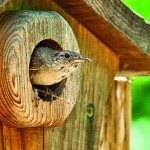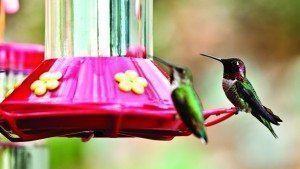Backyard Birds and Butterflies, Native Habitats Draw Critters and Delight Kids
Creating a backyard wildlife habitat provides valuable teaching moments. With planning and care, birds, bats, butterflies and bunnies can view yards as safe havens and sources for food, water and shelter, providing endless fascination.
Josh Stasik, a father of three and owner of Sweet-Seed.com, in Syracuse, New York, sees firsthand how feeding winged wonders can be an inexpensive way to start a new family activity. “My mom taught me about flowers and bird feeders. I hope my kids will someday pass the information along to their children,” he says.
 Habitat plantings and available foods determine what creatures will visit. “Native plants attract native bugs that are eaten by native birds and bats,” observes Stasik, noting that staff at extension services and garden centers can provide helpful advice.
Habitat plantings and available foods determine what creatures will visit. “Native plants attract native bugs that are eaten by native birds and bats,” observes Stasik, noting that staff at extension services and garden centers can provide helpful advice.
Based on his own research, Stasik knows, “Bird species have definite tastes in food. Bluebirds love mealworms. Hummingbirds like floral nectars. Orioles look for citrus fruit. Butterflies are eclectic sippers of both floral and citrus.”
Hummingbirds pose particular appeal for kids and adults because they appear always on the move. Hummingbirds.net/map.html follows their migration sites.
Videographer Tom Hoebbel, owner of TH Photography, outside Ithaca, New York, builds birdhouses and nesting boxes with his kids. They also participate in the annual Christmas bird count for the Audubon Society (Birds.Audubon.org/Christmas-bird-count). The Great Backyard Bird Count, a joint project between nonprofits Audubon and the Cornell Lab of Ornithology, follows in February (gbbc.BirdCount.org).
“In our yard, we have five nesting boxes made from reused wood. Once or twice a week, we check to see who lives there and how many eggs there are,” says Hoebbel. “So far, we’ve seen bluebirds, chickadees and house wrens.”
He laments the rapid decline of bats in the Northeast due to pesticides killing bugs, the main course for birds and bats. “In the winter, bats live in caves, so we put one-by-one-foot boxes in the yard for their summer homes.” Warm evenings on the patio are more enjoyable when bats clean up the mosquito population; a single bat can eat as many as 1,000 in an hour.
The monarch butterfly population is another favorite species in decline, with the spectacular annual migration on the verge of disappearing due to illegal deforestation, climate change, expansion of crop acreage and imposition of genetically modified plants that reduce the growth of native species. “You can help them by planting perennial milkweed in your garden,” advises Brande Plotnick, founder of Tomato Envy, in Jenkintown, Pennsylvania. Milkweed is the food of choice because it makes the caterpillars and butterflies toxic to birds and other predators. Also consider planting garden phlox, coneflower and lantana. Migrating monarchs live about nine months and fly up to 30 miles per hour.
Plotnick also suggests planting an herb garden that includes parsley. “Swallowtail butterflies will lay eggs on parsley, caterpillars hatch and feed on it, and eventually create a chrysalis,” she says. “You’ll be able to see the entire butterfly life cycle.”
 Rabbits add another dimension to backyard wildlife. Just as birds and butterflies need trees, bushes and plants to land on and hide in, bunnies need ground cover. The Virginia Department of Game and Fisheries counsels that brush piles should start with a base of large limbs, logs or stones to raise the floor above ground and create tunnels and escape routes, plus a home base. Top with smaller branches and maybe a recycled Christmas tree or dead plants. Encourage structural density and permanence with live vines. The resulting brush pile should be igloo-shaped and about six to eight feet tall and wide. Visit Tinyurl.com/BunnyShelters.
Rabbits add another dimension to backyard wildlife. Just as birds and butterflies need trees, bushes and plants to land on and hide in, bunnies need ground cover. The Virginia Department of Game and Fisheries counsels that brush piles should start with a base of large limbs, logs or stones to raise the floor above ground and create tunnels and escape routes, plus a home base. Top with smaller branches and maybe a recycled Christmas tree or dead plants. Encourage structural density and permanence with live vines. The resulting brush pile should be igloo-shaped and about six to eight feet tall and wide. Visit Tinyurl.com/BunnyShelters.
City ordinances or subdivision regulations might prohibit brush piles in ordinary yards. Find out how to gain certification as a wildlife habitat through the National Wildlife Federation at Tinyurl.com/CertifiedWildlifeHabitat.
Rabbits can have as many as seven babies per litter, depending on the species. Make sure their space is sufficient. Before attracting bunnies to the yard, be aware of local predators—hawks, owls, coyote, dogs and stray cats. The brush pile may also attract other animals like skunks, raccoons and reptiles.
A wildlife habitat is a fun, ongoing learning experience. It calls on math skills for bird counts, geography to follow migration maps and woodworking to build homesites and feeding spots. It becomes a lesson in local ecology and the roles of native plants and animals. When children comprehend they can help save wildlife, it’s also a lesson in hope.
Avery Mack is a freelance writer in St. Louis, MO. Connect via AveryMack@mindspring.com.

Hummingbird Nectar Recipe
Measure one part ordinary white sugar to four parts water (no unhealthy red dye needed). Boil the water first, and then mix the nectar while the water is hot; the sugar will easily dissolve.
Source: TomatoEnvy.com
Habitat Tips
Recognize the basic needs of all wildlife; food, water, cover and safe places to raise young.
- Determine the most desirable species to attract and learn their specific needs.
- Evaluate current yard habitat conditions for missing elements.
- Develop a plant list; select for wildlife value, emphasizing native plants suitable for the region.
- Realize that habitat will grow larger and mature.
- Certify the family’s backyard wildlife habitat through the National Wildlife Federation.
Source: Education Department at Callaway Gardens, Pine Mountain, GA
<












